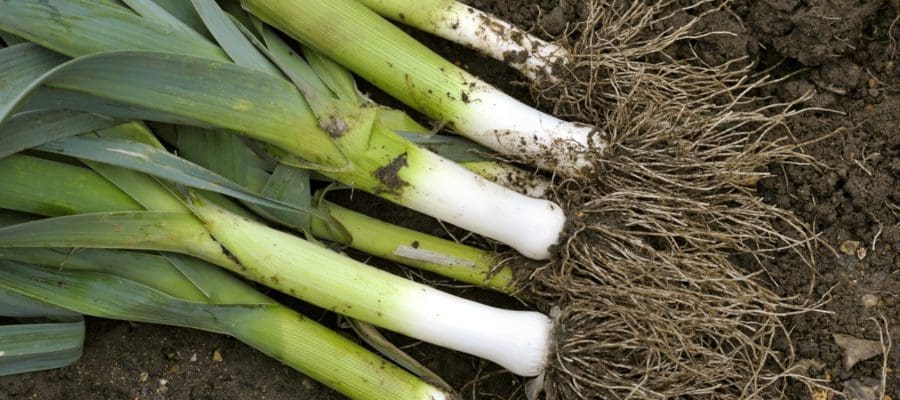Leeks have to be king of the winter vegetables and probably the most popular to grow and eat at this season of the year. It is also the easiest of the onion family to grow and generally undemanding.
It will tolerate a range of winter conditions, from wet to very cold, and once mature it can be left in the ground for weeks while you harvest what you want. You can also extend the cropping period by choosing different varieties to grow. Some will mature sooner than others, so harvesting can be as early as the autumn.
Varieties
- ‘Bandit’
A new variety that is described as outstanding for the garden. It has lovely dark green leaves and pure white stems and has been shown to have good resistance to bolting (going to flower and seed) and rust disease. - ‘Oarsman F1’
The stems bulk up quickly on this variety making it a good mid-season leek. - ‘Carlton’
Another early variety producing good long white stems that are ready for harvesting in September right through to November. Has an RHS Award of Garden Merit. - ‘Musselburgh’
A popular mid-season variety that produces shorter chunky stems. - ‘Pancho’
A very early maturing variety, but will still remain in good condition if left in the ground for the winter. Also has an RHS Award of Garden Merit. - ‘Toledo’
A strong-growing reliable variety that can be harvested from November to late February.

Sowing & Growing Leeks
Leeks like a sunny spot and a good fertile soil, so add plenty of garden compost or farmyard manure to the site. A week or two before planting sprinkle some Grow more or chicken manure pellets over the soil.
Leeks can be sown in a seed-bed on the plot or in cell trays or pots. If sowing outdoors prepare a small area of ground and dig and rake to a nice crumbly surface.
Make a groove (drill) in the soil and water the bottom. Sow the leek seed thinly along the row, about 13mm (1⁄2in) between each seed. Cover with some soil and when the seedlings are through remove every other one to leave 2.5cm (1in) between each seedling.
When these have reached nearly pencil thickness, by about June, they can be carefully lifted and planted out where they are to grow and be harvested.
If starting off in cell trays, fill with some multi-purpose compost and sow one seed per cell. By June they should be ready for planting out. Before planting out leeks, soak the soil the day before if possible. Then put out a line of string and make 15cm (6in) deep holes with a trowel or dibber along the row at 15cm (6in) apart.
If planting more than one row make these 30cm (12in) apart. Drop a leek plant into each hole and then pour in a generous amount of water, which will settle the soil around the roots. Don’t fill in the hole with more soil just leave the plant as it is.
Growing on leeks
Keep the leeks well watered. If the young plants are allowed to dry out at any time, it may induce bolting (flowering).
Once the leeks have established it is worth earthing up the stems a little. Simply rake up the soil around the base of the stems to help blanch them (produce alonger white shank).
A general-purpose feed applied when you water the leeks will help bulk up the stems, but stop feeding by about August.
Leeks are prone to a disease called rust, which as its name suggests looks like little flecks of gingery rust on the leaves. It is not something you can control but, fortunately, it is something that most leeks just grow through and is not too detrimental to the crop.
Scrumptious recipes for your homegrown leeks
More grow guides
For more growing tips and guides, you should subscribe to Kitchen Garden – you’ll receive free seeds with every single issue too!





